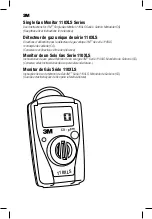
0
Fig.
Fig. 4
Over Range Alarm
An over range alarm is indicated by a flashing display showing the highest value
in the range of the sensor: 99 ppm for CO (Fig. ). The alarm indicators are the
same as those for the normal alarm.
Low Battery Alarm
If battery capacity reaches a point where it is no longer sufficient to maintain
operation of the unit, the LCD will display “bAt” (Fig. 4). Press button to
acknowledge and silence the alarm. Do not use until battery is replaced by a M
Service Center.
A calibration verification test (Bump test) should be performed before every use. This is done by checking
the monitor’s response to a known concentration of certified calibration gas. Calibration of the unit must be
performed at least every 0 days or immediately if it does not pass a calibration verification test. Sensors used
beyond the warranty period or exposed to very high concentrations of gas may require more frequent testing.
NOTE:
The instrument has been calibrated prior to being shipped from the factory. However, to ensure it is
performing correctly, a calibration or calibration verification test must be performed prior to initial use.
Alarm Mode Table
Alarm Mode Display
Alarm Sequence
Alarm
Gas Concentration and
“ALARM”
Repeating Alarm Cycle:
Three . sec. alarm sequences (vibrate, double beep/double
flash) followed by five . sec. alarm sequences (double
beep/double flash). Repeats cycle.
TWA
Gas Concentration
alternates with “tA”
Repeating Alarm Cycle:
Three . sec. alarm sequences (vibrate, double beep/double
flash) followed by five . sec. alarm sequences (double
beep/double flash). Repeats cycle.
STEL
Gas Concentration
alternates with “StL”
Repeating Alarm Cycle:
Three . sec. alarm sequences (vibrate, double beep/double
flash) followed by five . sec. alarm sequences (double
beep/double flash). Repeats cycle.
Over Range
“HIGH ALARM” and
flashing of highest value
in the range of sensor
(99 ppm CO)
Repeating Alarm Cycle:
Three . sec. alarm sequences (vibrate, double beep/double
flash) followed by five . sec. alarm sequences (double
beep/double flash). Repeats cycle.
Error
Err
Double beep/double flash every 40 seconds
Fail
FAil
No audible, visual or vibrating alarm
Low Battery
bAt
Double beep/double flash every 40 seconds
Calibration Verification Test and Calibration
WARNING
The following steps must be performed when conducting a calibration or calibration verification test
(bump test) to ensure proper performance of the monitor. Failure to do so may adversely affect product
performance and
result in sickness or death.
– Calibrate prior to initial use.
– When performing a calibration or calibration verification test (bump test) only use certified
calibration gas at the required concentration level. Do not calibrate with expired calibration gas.
– A calibration verification test (bump test) should be performed before each use.
– If the instrument cannot be calibrated, do not use until the reason can be determined and corrected.
– Do not cover or obstruct display, audible alarm opening or visual alarm cover.
– Ensure sensor inlet is unobstructed and is free of debris.
– Ensure calibration hood is removed prior to use.
Performing a Calibration Verification Test (Bump test)
A calibration verification test (bump test) should be conducted every time you use
the monitor. This is the only way to effectively confirm that all characteristics of
the monitor and the sensors are working correctly.
Ensure that you are in a non-contaminated environment before performing a
calibration verification test. To conduct the test, attach the calibration (cal) hood
on top of the sensor inlet. Ensure the calibration gas matches the sensor installed
in the instrument. Connect the hose from the gas regulator of the calibration gas
bottle to the cal hood (Fig. ). Turn on the gas.
Compare the displayed values with those of your reference calibration gas source.
Apply the calibration gas for a period of at least - minutes to ensure sufficient
response time and steady state readings. If the measurement displayed is within
±0% of the calibration gas concentration, turn off the calibration gas and
remove the cal hood. The unit is now ready for use. Otherwise a calibration should
be performed.
Fig.
CO - ppm
110
Performing a Calibration
Ensure that you are in a non-contaminated environment
before entering calibration mode. From normal mode
press the button once; the self-test will be performed
and “CAL” will be displayed (Fig. 6). Press the button
within seconds and the unit will enter calibration mode
indicated by “000” displayed on the LCD (Fig. 7). If the
unit passed this zeroing step, the display will change to
“SPn” alternating with “YES” (Fig. 8 & 9). Press button
to complete calibration with a gas span. Apply gas when
the display indicates “GAS” alternating with the expected
gas level (Fig. 0). Apply the appropriate gas ( ppm for
CO) within 0 seconds.
Once the gas is sensed the display will read “SPn”
alternating with the expected gas level. The calibration
will take approximately – minutes. Upon successful
completion, the display will show the gas reading. Turn off
the gas and remove the cal hood.
If calibration fails, the “FAIL” message will be displayed
(Fig. ). Repeat calibration steps. If the instrument still
fails to calibrate, do not use.
Do not use the instrument
until the reason for the “FAIL” message has been
determined and corrected.
Fig. 6
Fig.
Fig. 0
Fig. 9
Fig. 8
Fig. 7







































